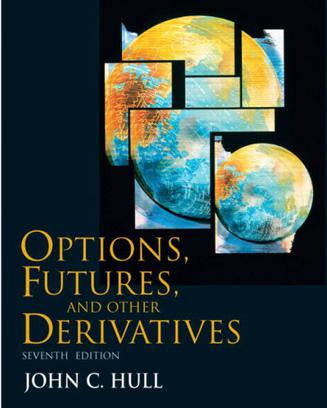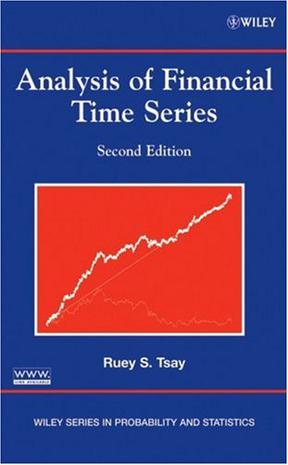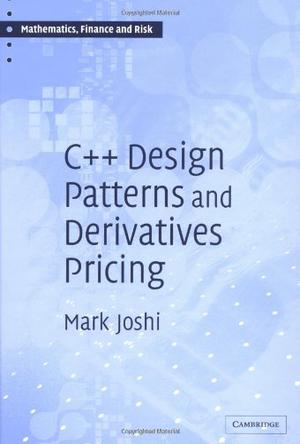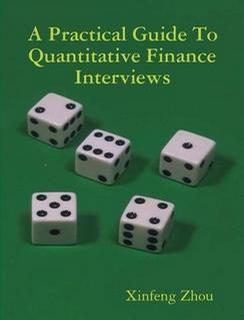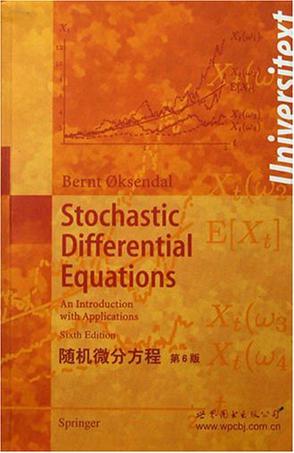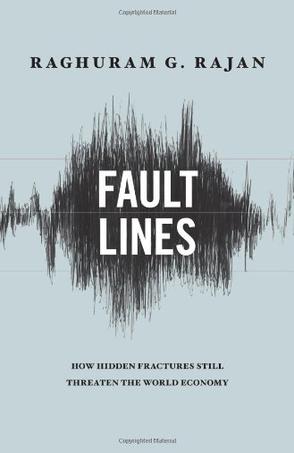欢迎来到相识电子书!
标签:finance
-
Analysis of Financial Time Series
This book provides a broad, mature, and systematic introduction to current financial econometric models and their applications to modeling and prediction of financial time series data. It utilizes real-world examples and real financial data throughout the book to apply the models and methods described. The author begins with basic characteristics of financial time series data before covering three main topics: Analysis and application of univariate financial time series The return series of multiple assets Bayesian inference in finance methods Key features of the new edition include additional coverage of modern day topics such as arbitrage, pair trading, realized volatility, and credit risk modeling; a smooth transition from S-Plus to R; and expanded empirical financial data sets. The overall objective of the book is to provide some knowledge of financial time series, introduce some statistical tools useful for analyzing these series and gain experience in financial applications of various econometric methods. -
Volatility and Correlation
In Volatility and Correlation 2 nd edition: The Perfect Hedger and the Fox , Rebonato looks at derivatives pricing from the angle of volatility and correlation. With both practical and theoretical applications, this is a thorough update of the highly successful Volatility & Correlation – with over 80% new or fully reworked material and is a must have both for practitioners and for students. The new and updated material includes a critical examination of the ‘perfect-replication’ approach to derivatives pricing, with special attention given to exotic options; a thorough analysis of the role of quadratic variation in derivatives pricing and hedging; a discussion of the informational efficiency of markets in commonly-used calibration and hedging practices. Treatment of new models including Variance Gamma, displaced diffusion, stochastic volatility for interest-rate smiles and equity/FX options. The book is split into four parts. Part I deals with a Black world without smiles, sets out the author’s ‘philosophical’ approach and covers deterministic volatility. Part II looks at smiles in equity and FX worlds. It begins with a review of relevant empirical information about smiles, and provides coverage of local-stochastic-volatility, general-stochastic-volatility, jump-diffusion and Variance-Gamma processes. Part II concludes with an important chapter that discusses if and to what extent one can dispense with an explicit specification of a model, and can directly prescribe the dynamics of the smile surface. Part III focusses on interest rates when the volatility is deterministic. Part IV extends this setting in order to account for smiles in a financially motivated and computationally tractable manner. In this final part the author deals with CEV processes, with diffusive stochastic volatility and with Markov-chain processes. Praise for the First Edition: “In this book, Dr Rebonato brings his penetrating eye to bear on option pricing and hedging.… The book is a must-read for those who already know the basics of options and are looking for an edge in applying the more sophisticated approaches that have recently been developed.” —Professor Ian Cooper, London Business School “Volatility and correlation are at the very core of all option pricing and hedging. In this book, Riccardo Rebonato presents the subject in his characteristically elegant and simple fashion…A rare combination of intellectual insight and practical common sense.” —Anthony Neuberger, London Business School -
MATHEMATICAL METHODS FOR FOREIGN EXCHANGE - A FINANCIAL ENGINEER'S APPROACH
This comprehensive book presents a systematic and practically oriented approach to mathematical modeling in finance, particularly in the foreign exchange context. It describes all the relevant aspects of financial engineering, including derivative pricing, in detail. The book is self-contained, with the necessary mathematical, economic, and trading background carefully explained. In addition to the lucid treatment of the standard material, it describes many original results. The book can be used both as a text for students of financial engineering, and as a basic reference for risk managers, traders, and academics. -
Building Financial Models
The ability to effectively create and interpret financial models is one of the most valued skills in corporate finance--from Wall Street to Main Street. Now, the acclaimed guide to designing, building, and implementing valuation projection models is fully revised and expanded to keep finance and accounting professionals competitive in today's marketplace. This second edition of Building Financial Models continues the tradition of its predecessor by providing a hands-on approach to creating a core model that is supported by broad coverage of cornerstone accounting and finance principles. Additionally, this updated volume features: Entirely new coverage of discounted cash flow (DCF) modeling Excel formulas for making powerful calculations within the spreadsheet In-depth explanations of both the principles and mechanics of projection models Building Financial Models helps readers practice good thinking and apply sound knowledge of their tools--two key attributes to producing robust and easy-to-use models. This practical guide takes you step by step through the entire process of developing a projection model, with a full chapter dedicated to each phase. By the end, you will have a working, dynamic spreadsheet financial model for making projections for industrial and manufacturing companies. Furthermore, this Second Edition provides the vocabulary and syntax of model building so you can tailor core models to fit any size company and allow for quick input changes to test sensitivity. The companion website www.buildingfinancialmodel.com offering example spreadsheets will give you a head start on developing your own models. A flexible and successful financial projection model does more than just add numbers--it explains the complex relationships between those numbers and illuminates ways to use those associations to add value to an enterprise. Building Financial Models is the only book you need to create and implement a fluid financial projection model that is both state of the art and user friendly. -
Elementary Stochastic Calculus With Finance in View (Advanced Series on Statistical Science & Applied Probability, Vol 6)
Modelling with the Ito integral or stochastic differential equations has become increasingly important in various applied fields, including physics, biology, chemistry and finance. However, stochastic calculus is based on a deep mathematical theory. This text should be suitable for the reader without a deep mathematical background. It seeks to provide an elementary introduction to that area of probability theory, without burdening the reader with a great deal of measure theory. Applications are taken from stochastic finance. In particular, the Black-Scholes option pricing formula is derived. -
Financial Calculus
The rewards and dangers of speculating in the modern financial markets have come to the fore in recent times with the collapse of banks and bankruptcies of public corporations as a direct result of ill-judged investment. At the same time, individuals are paid huge sums to use their mathematical skills to make well-judged investment decisions. Here now is the first rigorous and accessible account of the mathematics behind the pricing, construction and hedging of derivative securities. Key concepts such as martingales, change of measure, and the Heath-Jarrow-Morton model are described with mathematical precision in a style tailored for market practitioners. Starting from discrete-time hedging on binary trees, continuous-time stock models (including Black-Scholes) are developed. Practicalities are stressed, including examples from stock, currency and interest rate markets, all accompanied by graphical illustrations with realistic data. A full glossary of probabilistic and financial terms is provided. This unique, modern and up-to-date book will be an essential purchase for market practitioners, quantitative analysts, and derivatives traders, whether existing or trainees, in investment banks in the major financial centres throughout the world. -
Arbitrage Theory in Continuous Time
The third edition of this popular introduction to the classical underpinnings of the mathematics behind finance continues to combine sound mathematical principles with economic applications. Concentrating on the probabilistic theory of continuous arbitrage pricing of financial derivatives, including stochastic optimal control theory and Merton's fund separation theory, the book is designed for graduate students and combines necessary mathematical background with a solid economic focus. It includes a solved example for every new technique presented, contains numerous exercises, and suggests further reading in each chapter. In this substantially extended new edition Bjork has added separate and complete chapters on the martingale approach to optimal investment problems, optimal stopping theory with applications to American options, and positive interest models and their connection to potential theory and stochastic discount factors. More advanced areas of study are clearly marked to help students and teachers use the book as it suits their needs. -
Numerical Methods in Finance and Economics
A state-of-the-art introduction to the powerful mathematical and statistical tools used in the field of finance The use of mathematical models and numerical techniques is a practice employed by a growing number of applied mathematicians working on applications in finance. Reflecting this development, Numerical Methods in Finance and Economics: A MATLAB?-Based Introduction, Second Edition bridges the gap between financial theory and computational practice while showing readers how to utilize MATLAB?--the powerful numerical computing environment--for financial applications. The author provides an essential foundation in finance and numerical analysis in addition to background material for students from both engineering and economics perspectives. A wide range of topics is covered, including standard numerical analysis methods, Monte Carlo methods to simulate systems affected by significant uncertainty, and optimization methods to find an optimal set of decisions. Among this book's most outstanding features is the integration of MATLAB?, which helps students and practitioners solve relevant problems in finance, such as portfolio management and derivatives pricing. This tutorial is useful in connecting theory with practice in the application of classical numerical methods and advanced methods, while illustrating underlying algorithmic concepts in concrete terms. Newly featured in the Second Edition: * In-depth treatment of Monte Carlo methods with due attention paid to variance reduction strategies * New appendix on AMPL in order to better illustrate the optimization models in Chapters 11 and 12 * New chapter on binomial and trinomial lattices * Additional treatment of partial differential equations with two space dimensions * Expanded treatment within the chapter on financial theory to provide a more thorough background for engineers not familiar with finance * New coverage of advanced optimization methods and applications later in the text Numerical Methods in Finance and Economics: A MATLAB?-Based Introduction, Second Edition presents basic treatments and more specialized literature, and it also uses algebraic languages, such as AMPL, to connect the pencil-and-paper statement of an optimization model with its solution by a software library. Offering computational practice in both financial engineering and economics fields, this book equips practitioners with the necessary techniques to measure and manage risk. -
A Practical Guide To Quantitative Finance Interviews
This book will prepare you for quantitative finance interviews by helping you zero in on the key concepts that are frequently tested in such interviews. In this book we analyze solutions to more than 200 real interview problems and provide valuable insights into how to ace quantitative interviews. The book covers a variety of topics that you are likely to encounter in quantitative interviews: brain teasers, calculus, linear algebra, probability, stochastic processes and stochastic calculus, finance and programming. -
A Practical Guide To Quantitative Finance Interviews
This book will prepare you for quantitative finance interviews by helping you zero in on the key concepts that are frequently tested in such interviews. In this book we analyze solutions to more than 200 real interview problems and provide valuable insights into how to ace quantitative interviews. The book covers a variety of topics that you are likely to encounter in quantitative interviews: brain teasers, calculus, linear algebra, probability, stochastic processes and stochastic calculus, finance and programming. -
随机微分方程
《随机微分方程》(第6版)是《Universitext》丛书之一,是一部理想的研究生教材,内容做了较大的修改和补充,包括鞅表示论、变分不等式和随机控制等内容,书后附有部分习题解答和提示。随机微分方程在数学以外的许多领域有着广泛的应用,它对数学领域中的许多分支起着有效的联结作用。 -
Stochastic Calculus for Finance I
Developed for the professional Master's program in Computational Finance at Carnegie Mellon, the leading financial engineering program in the U.S. Has been tested in the classroom and revised over a period of several years Exercises conclude every chapter; some of these extend the theory while others are drawn from practical problems in quantitative finance -
Stochastic Calculus for Finance II
在线阅读本书 Stochastic Calculus for Finance evolved from the first ten years of the Carnegie Mellon Professional Master's program in Computational Finance. The content of this book has been used successfully with students whose mathematics background consists of calculus and calculus-based probability. The text gives both precise statements of results, plausibility arguments, and even some proofs, but more importantly intuitive explanations developed and refine through classroom experience with this material are provided. The book includes a self-contained treatment of the probability theory needed for stochastic calculus, including Brownian motion and its properties. Advanced topics include foreign exchange models, forward measures, and jump-diffusion processes. This book is being published in two volumes. This second volume develops stochastic calculus, martingales, risk-neutral pricing, exotic options and term structure models, all in continuous time. Master's level students and researchers in mathematical finance and financial engineering will find this book useful. -
Liar's Poker
Liar's Poker is a non-fiction, semi-autobiographical book by Michael Lewis describing the author's experiences as a bond salesman on Wall Street during the late 1980s. First published in 1989, it is considered one of the books that define Wall Street during the 1980s, along with Barbarians at the Gate and the fictional The Bonfire of the Vanities by Tom Wolfe. The book captures well an important period in the history of Wall Street. Two important figres in that history feature prominantly in the text, head of mortgage department Lewie Ranieri and firm CEO John Gutfreund. The book's name is taken from Liar's poker, a gambling game popular with the bond traders in the book and played for high stakes. Liar's Poker follows two different story threads, though not necessarily in chronological order. The first thread is autobiographical, and follows Lewis through his college education and his hiring by Salomon Brothers in 1984. This part of the book gives a first-person account of how bond traders and salesmen truly work, their personalities, and their culture. The book captures well an important period in the history of Wall Street. Two important figures in that history feature prominently in the text, head of mortgage department Lewie Ranieri and firm CEO John Gutfreund. The second thread is a sort of history of Salomon Brothers and overview of Wall Street in general, especially how the firm single-handedly created a market for mortgage bonds and made the firm wealthy, only to be outdone by Michael Milken and his junk bonds. This thread is less dependent on Lewis' personal experience and features quotes apparently drawn from interviews with various relevant figures. Lewis jumps back and forth between these two threads in the book. -
What Social Classes Owe to Each Other
The title of this 1883 classic of laissez-faire economics and sociology is ironic: the social classes do not, the author concludes, owe each other anything. Demolishing the theory of group obligation and fully embracing the concepts of dog-eat-dog social Darwinism, Sumner rages against the notion that the educated and wealthy have any obligation to the poor and uneducated, declares that the men should simply pull themselves out of poverty, deems taxes an obscenity and universal suffrage "immoral and vicious," dismisses the idea of "natural rights," and decries anything other than "every man for himself." A stunning evocation of modern libertarianism taken to its logical extreme, What Social Classes Owe to Each Other presents a bleak vision of contemporary industrial society... one valuable for those on all sides of the issue to understand and appreciate. American academic and author WILLIAM GRAHAM SUMNER (1840-1910) was an influential professor of sociology and politics at Yale College and president of the American Sociological Association from 1908 to 1909. He wrote numerous and varied books including Andrew Jackson as a Public Man (1882) and Folkways (1906).
热门标签
下载排行榜
- 1 梦的解析:最佳译本
- 2 李鸿章全传
- 3 淡定的智慧
- 4 心理操控术
- 5 哈佛口才课
- 6 俗世奇人
- 7 日瓦戈医生
- 8 笑死你的逻辑学
- 9 历史老师没教过的历史
- 10 1分钟和陌生人成为朋友

